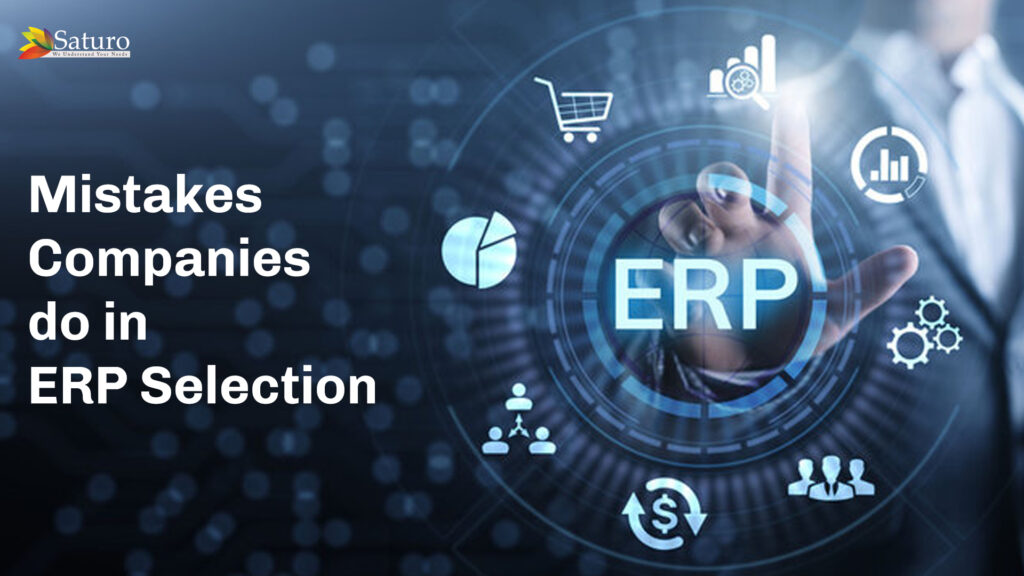
Every business has its own objectives, processes, and requirements. Above all, today’s businesses need technologies with full functions that can bridge the gap between business processes and people. To successfully run a large organization with multiple departments and teams, an ERP system helps by synchronizing all information and communication within the organization. ERP is a combination of software and company activities performed to manage operations. Although ERP is a considerable investment of money, resources, and time for any organization, with its ease the entire project value chain aligns, and key processes are effectively streamlined.
Being a good picture for the organization, many leaders fall for the following mistakes while choosing the right ERP for their organization and end up with their money, time, and the anticipated growth of their organization:
Mistake. 1 – Poor planning
Introducing ERP tools into your current workflow will affect every domain in your organization (including sales, marketing, engineering, finance and accounts, purchasing, and operations). A successful ERP implementation requires strategic planning and careful analysis. But, unfortunately, most enterprises do not implement proper planning, and consequently, ERP projects crash. You can see a case study of choosing a strange ERP solution here: https://www.itbusiness.ca/news/4-it-lessons-learned-from-target-canadas-failure-as-documented-by-canadian-business/64199
Mistake. 2 – Not preparing your Needs
Integrating ERP can redesign and improve your entire business process. But most enterprises struggle to find the right ERP solution for their organization, and the reasons are:
- Not properly assessing business requirements.
- Not addressing business-critical issues before migrating to the new ERP architecture.
- Failure in mapping software usage issues.
To find an ERP system that exactly matches the needs of your business, you should consider the following:
- Conduct meetings with your team to evaluate your business needs.
- Identify problem areas in your workflow, such as irregular tracking of sales and orders, improper management, and more.
- Understand your current system architecture and design so that the best compatible ERP system can be detected.
Once you prepare your requirements, it will be easy for you to select and deploy ERP solutions in your existing system.
Mistake. 3 – Getting distracted by features and cheap pricing.
Often, enterprises are fascinated by the expanded features that an ERP offers. And later, when it comes time to implement ERP, they find that the system lacks some specific functionality for your business needs. Instead of being dazzled by the long matrix features of ERP, you should consider a solution that addresses your business needs and, as quality comes with a price, look after reliable ERP rather than cheaper ERP. There are many cases where companies have faced tremendous challenges in the selection of local and simple ERPs.
Mistake. 4 – Not including end users when making decisions
Implementation of the ERP process is an important and costly project for any organization. But, most of the time, when implementing an ERP system, many enterprises devote their time and efforts to getting approval from higher authorities. They do not include the end-users who would spend the most time using the ERP system. As a result, the implementation process deteriorates.
Mistake. 5 – Not analyzing the differences between custom ERP and cloud-based ERP to suit their business needs.
To understand the difference between a custom ERP and a pre-packaged ERP, read the following:
- Custom ERP
- It is developed on your own premises based on your company experience.
- It is suitable for organizations that want to host and implement ERP solutions on their own servers.
- It requires dedicated staff, compatible in-house hardware, and dedicated servers.
- Pre-packaged or Cloud ERP
- It comes with pre-built features that are verified and validated before the software is made available to the public.
- It mostly subscribes to SAAS on a monthly basis and helps employees who work remotely.
- It requires a strong internet connection and membership-based payments.
Mistake. 6 – Not following the right procedure
Selecting, implementing, and deploying an ERP system is complex. And if you try to do it all at once, your project will take a longer time to go live. To reduce the delay, you need to adopt an active approach instead of a waterfall model.
Using an agile approach when implementing an ERP system can help you find and analyze needs at every step. Whereas, in the waterfall methodology, business analysts outline the requirements of the project in the beginning only.
Now when we take a look at the above mistakes, we understand that these mistakes are quite common in most organizations, and we can minimize these if we could take the help of some trusted ERP brands in the world who have a track record of solving these ERP challenges. A few of the truest names we may look at our Oracle NetSuite, SAP, Microsoft, SAGE & QuickBooks. You have to look at the current ranking of the trusted ERPs here: https://financesonline.com/12-best-cloud-based-erp-software/
Oracle NetSuite ERP is an all-in-one cloud business management solution that helps organizations operate more effectively by automating core processes and providing real-time operational and financial performance visibility. With a single, integrated suite of applications for managing accounting, inventory management, order processing, production, supply chain, and warehouse operations, NetSuite ERP gives companies clear visibility into their data and tighter control over their businesses.
To Know more about Oracle NetSuite Cloud ERP, feel free to reach us on:
Website: https://www.saturotech.com
Email ID: marketing@saturotech.com
Saturo Social Media Links:
- Facebook: https://www.facebook.com/saturotech/
- Instagram: https://www.instagram.com/saturotechnologies/
- LinkedIn: https://www.linkedin.com/company/saturo-technologies-private-limited/
- Twitter: https://twitter.com/saturotech
- YouTube: https://www.youtube.com/channel/UC69yIWnRwPV04KydM64sXTw/videos
To Read More of our Blogs Visit: https://billmade.com/index.php/blogs/